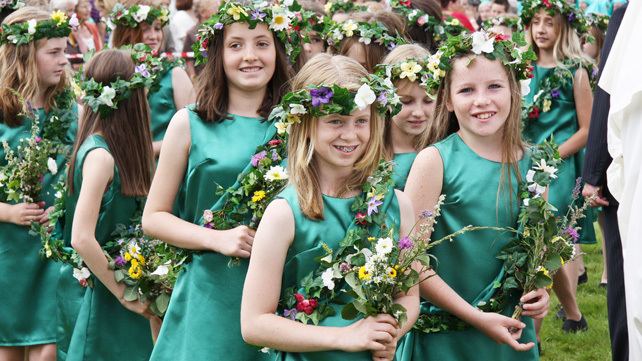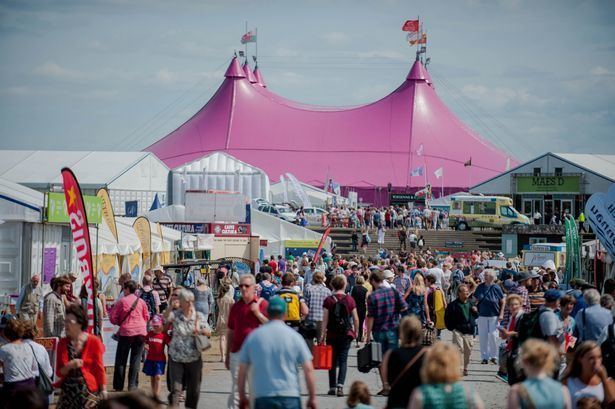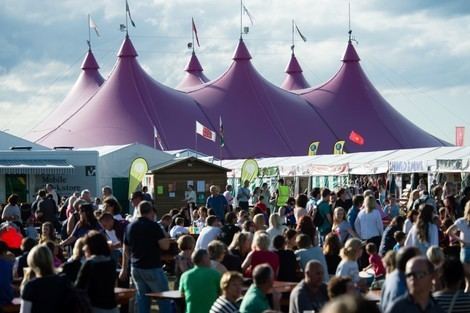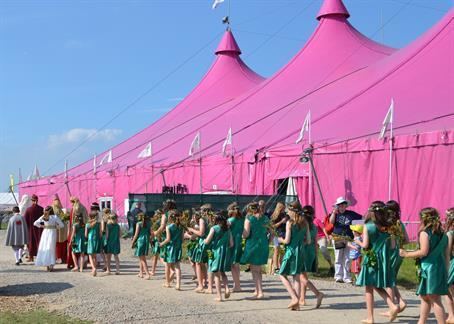Country Wales | Established 1861 (1861) Dates 4 Aug – 12 Aug 2017 | |
 | ||
Similar Urdd National Eisteddfod, Cymanfa Ganu, Sŵn, Brecon Jazz Festival, North American Festival o Profiles | ||
National eisteddfod of wales 2016 proclamation ceremony at caldicot castle 27 6 15 dscn4336
The National Eisteddfod of Wales (Welsh: Eisteddfod Genedlaethol Cymru) is the most important of several eisteddfodau (festivals) that are held annually, mostly in Wales. Its eight days of competitions and performances are considered the largest music and poetry festival in Europe. Competitors typically number 6,000 or more, and overall attendance generally exceeds 150,000 visitors.
Contents
- National eisteddfod of wales 2016 proclamation ceremony at caldicot castle 27 6 15 dscn4336
- National eisteddfod of wales entertainment at caldicot town centre 27 6 15 dscn4291
- Overview
- History
- National Eisteddfod venues
- References

National eisteddfod of wales entertainment at caldicot town centre 27 6 15 dscn4291
Overview

The National Eisteddfod is traditionally held in the first week of August, and (since 1952) the competitions are all held in the Welsh language.

The venue is officially proclaimed a year in advance, at which time the themes and texts for the competitions are published. The organisation for the location will have begun a year or more earlier, and locations are generally known two or three years ahead. The Eisteddfod Act of 1959 allowed local authorities to give financial support to the event. Traditionally the Eisteddfod venue alternates between north and south Wales; the decision to hold both the 2014 and 2015 Eisteddfodau in South Wales was thus seen as controversial, but the decision was later reversed and Montgomeryshire named as host county for 2015. Occasionally the Eisteddfod has been held in England; this is noted in italics in the following table of past locations.

Hundreds of tents, pavilions and booths are erected in an open space to create the maes (field). The space required for this means that it is rare for the Eisteddfod to be in a city or town: instead it is held somewhere with more space. Car parking for day visitors alone requires several large fields, and many people camp on the site for the whole week.

The festival has a quasi-druidic flavour, with the main literary prizes for poetry and prose being awarded in colourful and dramatic ceremonies under the auspices of the Gorsedd of Bards of the Island of Britain, complete with prominent figures in Welsh cultural life dressed in flowing druidic costumes, flower dances, trumpet fanfares and a symbolic Horn of Plenty. However, the Gorsedd is not an ancient institution or a pagan ceremony but rather a romantic creation by Iolo Morganwg in the 1790s, which first became part of the Eisteddfod ceremonial in 1819. Nevertheless, it is taken very seriously, and an award of a crown or a chair for poetry is a great honour. The Chairing and Crowning ceremonies are the highlights of the week, and are presided over by the Archdruid. Other important awards include the Prose Medal (first introduced in 1937).
If no stone circle is there already, one is created out of Gorsedd stones, usually taken from the local area. These stone circles are icons all across Wales and signify the Eisteddfod having visited a community. As a cost-saving measure, the 2005 Eisteddfod was the first to use a temporary "fibre-glass stone" circle for the druidic ceremonies instead of a permanent stone circle. This also has the benefit of bringing the Gorsedd ceremonies onto the maes: previously they were often held many miles away, hidden from most of the public. The ceremonies may still be held elsewhere if the weather at the maes is not considered suitable.
As well as the main pavilion with the main stage, there are other venues through the week. Some are fixtures every year, hosting gigs (Maes B/Llwyfan y Maes/Caffi Maes B). Other fixtures of the maes are the Pabell Lên (literature pavilion), the Neuadd Ddawns (dance hall), the Pabell Wyddoniaeth a Thechnoleg (science and technology pavilion), Maes D (learners' pavilion), at least one theatre, Y Cwt Drama (the drama hut), Tŷ Gwerin (folk house), Y Lle Celf ("the art place") and hundreds of stondinau (stands and booths) where groups, societies, councils, charities and shops exhibit and sell. Some eisteddfod-goers never go near the main pavilion, but spend their time wandering the maes and meeting friends. Since 2004, alcohol has been sold on the maes; previously there was a no-alcohol policy. Local theatres are likely to time Welsh-language productions for around the time of the Eisteddfod, hoping to benefit from the influx of visitors.
History
Though there were earlier Eisteddfodau held on a national scale in Wales, such as the Gwyneddigion and Provincial Eisteddfodau, the National Eisteddfod of Wales as an organisation traces its history back to the first event held in 1861, in Aberdare. One of the most dramatic events in Eisteddfod history was the award of the 1917 chair to the poet Ellis Humphrey Evans, bardic name Hedd Wyn, for the poem Yr Arwr (The Hero). The winner was announced, and the crowd waited for the winner to stand up to accept the traditional congratulations before the chairing ceremony, but no winner appeared. It was then announced that Hedd Wyn had been killed the previous month on the battlefield in Belgium. These events were portrayed in the Academy Award nominated film Hedd Wyn.
In 1940, during the Second World War, the Eisteddfod was not held, for fear that it would be a bombing target. Instead, the BBC broadcast an Eisteddfod radio programme, and the Chair, Crown and a Literature Medal (as opposed to the usual Prose Medal) were awarded.
In recent years efforts have been made to attract more non-Welsh speakers to the event. This has helped increase takings, and the 2006 Eisteddfod reported a profit of over £100,000, despite costing £2.8m to stage. The Eisteddfod attracts some 160,000 people annually. The number of visitors to the 2004, 2005 and 2006 events were respectively 147,785; 157,820; and 155,437. The National Eisteddfod in Cardiff (2008) drew record crowds, with over 160,000 visitors attending.
National Eisteddfod venues
The Eisteddfod has visited all the traditional counties of Wales. It has visited five of the six cities in Wales: Bangor, Cardiff, Newport, St David's and Swansea; but has never visited St Asaph.
